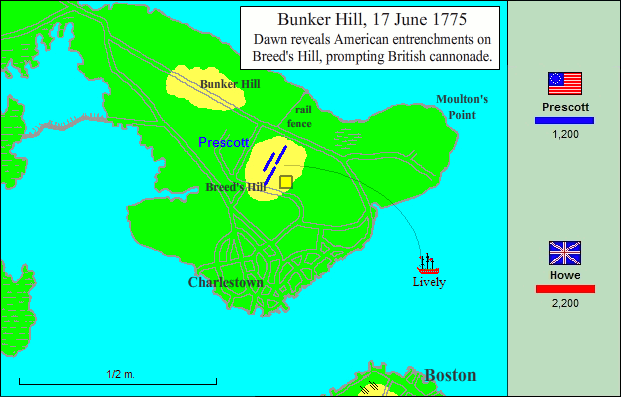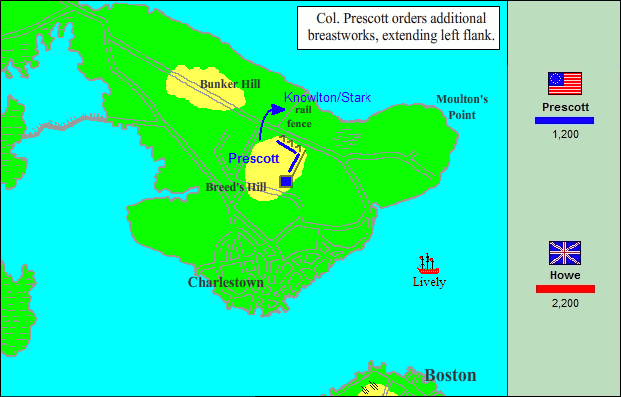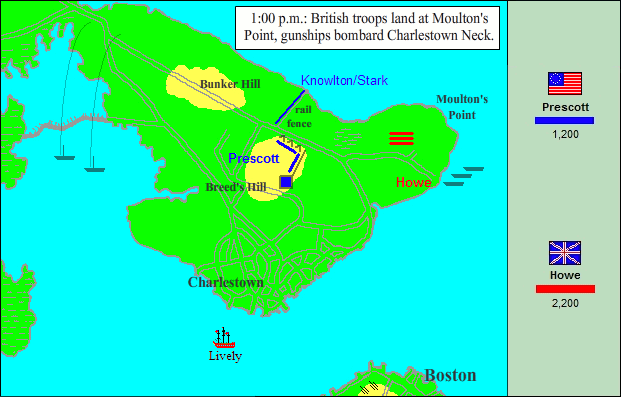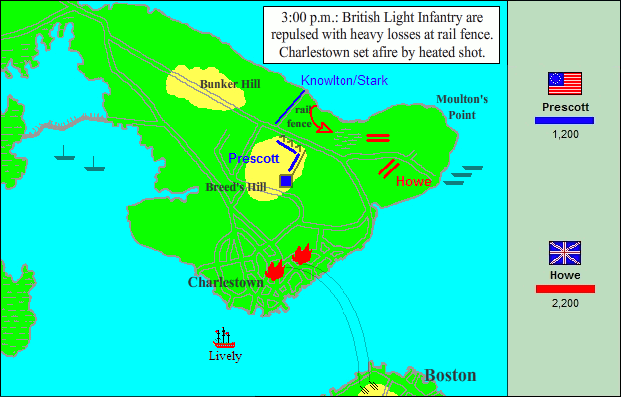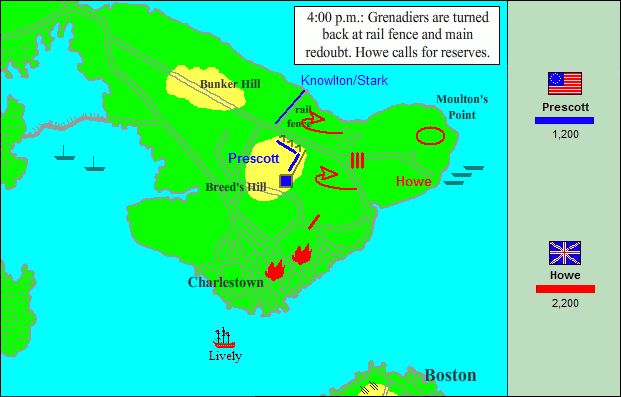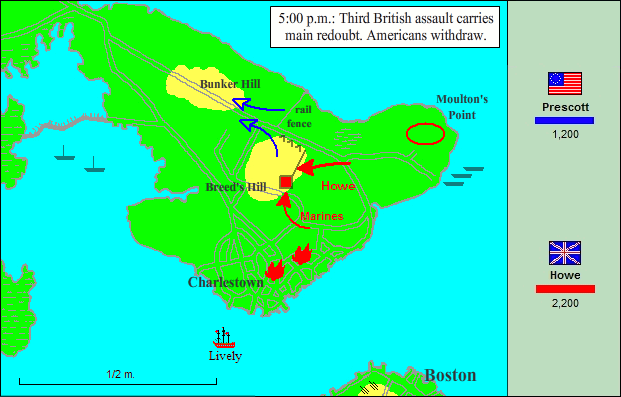[The Regulars] advanced toward us in order to swallow us up, but they found a choaky mouthful of us.
–militiaman Peter Brown, in a letter to his mother
While orders went out to burn Charlestown, Major General Howe gave a brief address to his troops, stating simply that he would not ask any man “to go a step further than where I go myself at your head.” It may be inferred thereby that he was determined to see that the decisive blow be well and properly struck. And yet even as the attacking force stepped off in common time, the British effort went awry. The jumping-off signal was a blast from two twelve-pounders posted on Moulton’s Point, at which time the grenadiers pushed several six-pounders forward in support of the attack against the rail fence. These got almost nowhere, bogging down in the clay and muck at the foot of Moulton’s Hill. As it turned out, though, there was no point dragging them forward at all, for when the gunners went to load them, they found the side boxes filled with twelve-pound balls. (Blame for this fell properly on one Colonel Cleaveland, chief of artillery, an aging Lothario, who, rumor had it, spent his best energies “dallying” with the daughters of a local schoolmaster.) At this point, all that the six-pounders could manage was firing grapeshot from well beyond effective range. Another opportunity for close-in artillery support–from Graves’ floating batteries–had already come and gone. Fire from the Mystic side of the peninsula might have blown the American left out of their lines, but by the time Howe thought of it, the tide had turned and there was no way to float them out of the Charles River basin.
In the end the battle would be decided by the infantry and at the point of the bayonet, which had a certain fitness since it was Howe’s original and firm resolve. And off they went: eleven companies of light infantry in column of fours down the strip of Mystic beach; to their left marched two broad lines of battle, grenadiers leading the way to the rail fence, the 5th and 52nd following in their wake. At the same time, Pigot’s wing extended the British front with their lines of battle: six flank companies plus the 38th and 43rd, and on their left the 47th and the 1st Marines, all closing on the redoubt and its supporting breastwork. But from the first it was difficult to keep their lines dressed. Although the light infantry on the beach had easy going, the grenadiers and their comrades marched down the slope of Moulton’s Hill and immediately into a swamp. Ahead were brick kilns, clay pits, and a dozen stone walls and fences to be negotiated, and most of the ground was waist-high in uncut meadow. The British left would have to make its way over similar walls and fences and directly up the slope of Breed’s Hill, and every man in the ranks hefting fifty or sixty pounds of gear.
But on they came at a pace that the Americans remembered as a “deliberate march.” Because they had the surest footing on the beach, the light infantry closed with the Rebels first. These were Stark’s New Hampshire men at the stone wall, waiting with a grim discipline that Billy Howe had not looked for. Over their leveled muskets, they could see the men of the redoubtable Royal Welsh Fusiliers tramping forward at the head of the column, four abreast and bayonets at the ready. The redcoats were thirty yards away and about to make their final rush when an order rang out from behind the wall. Then erupted a tearing sheet of flame, a cloud of dirty blue powder smoke, and a storm of buck and ball. The Royal Welsh were staggered in their tracks. The next company–it was from the King’s Own–pressed on, clambering over the fallen, but the American fire likewise tore into their close-packed ranks. Still they came on, each new company to be mauled in its turn, dead men sprawled and silent, wounded men writhing and groaning. Then they could bear no more. Running now in frank defeat, they did not stop until they had reached the point where they had first come ashore. Officers there, one remembered, tried to rally them “with the most passionate gestures,” even pushing “forward ye men with their swords.” But the men knew a hopeless case when they saw it. “Our Light Infantry were served up in companies,” said a British officer. John Stark, using an incongruously pastoral simile to describe so ghastly a sight, remembered that the dead “lay as thick as sheep in a fold.” The maimed and the crippled were making their way off the bloody beach as best they could.
In the rank meadow above the beach, the grenadiers were closing with the Rebels at the rail fence. About the same time they were climbing over the final barrier, they could hear–but not see–the ripping of musketry being poured into the light infantry off to their right. In an after-action report, Howe praised the “laudable perseverance” of his grenadiers and the gallantry of their officers, but he was willing to admit that they attacked without “the greatest share of discipline.” The idea here, as on the beach, was to overwhelm the defenders with the bayonet. But, as Howe wrote, the grenadiers were “checked by a difficulty they met with in getting over some very high fences of strong railing, under a heavy fire, well kept up by the rebels.” Instead of driving home with the bayonet, they “began firing, and by crowding fell into disorder, and in this state the 2nd line mixt with them.” On the American side, discipline was not perfect, but it was, for raw militiamen, surprisingly steady. As the redcoats got inside of a hundred yards, some of Knowlton’s men, not many, began to bang away–against orders. (An unexpectedly good thing for the Americans it was, since this fire incited the grenadiers to let fly with their own mainly harmless volleys.) But Israel Putnam was at the rail fence, vowing that he would shoot the next man who fired without orders. Now, according to one tradition, he bellowed: “Don’t fire until you see the whites of their eyes.” Whether Putnam actually delivered the famous utterance attributed to him is not clear and beside the point really. On the battlefield, the point was brutally clear: the Americans at the rail fence did in fact wait until they could see the whites of British eyes.
When the attackers were inside of fifty yards, the rail fence exploded with rattling volleys that staggered the grenadiers like the light infantry before them. The Rebels “rose up and poured in so heavy a fire that the oldest officers say they never saw a sharper action,” wrote youthful Lord Rawdon. Most of the grenadier companies, another survivor recalled, at “the moment of presenting themselves lost three-fourths and many nine-tenths of their men.” The 5th and 52nd, already in some disorder, came up behind and then through the battered grenadiers. But these too met the same “incessant stream of fire from the rebel lines.” Before long, leaving their dead and wounded in the waist-high grass, they were driven back in their turn. In the meantime, the attack on their left was faring no better. Though never intended as the decisive blow, Pigot had gone forward with the 47th and the 1st Marines, striking the redoubt front and flank. Prescott later testified to the “warm reception” his comrades afforded their English cousins and “the very smart firing” they were treated to in return. But the men of the 47th got within thirty paces of the Rebel work and no farther. The Marines tried to reach around the south face of the fort only to be caught between two fires–one from the fort and one from the direction of their own left flank. There Americans posted in a barn, some outbuildings, and behind walls and fences banged away stubbornly at the redcoat line with the burning village at their backs! It was enough. Pigot’s attack stalled and withdrew down the hill. Along the entire front of the British assault, the Regulars were now in full retreat. The Americans had seen the whites of their eyes, and now, to their elation, perhaps to their astonishment, they were seeing the backs of their scarlet coats.
A captain in Reed’s New Hampshire outfit remembered the jubilant “huzzaing” of his fellows, “supposing, at the time, we had driven the enemy.” But Howe and his troops, though much bloodied, were by no means broken. It took time–perhaps a quarter of an hour–for the general and his officers to rally and reform their men. Howe would not try again to force the stone wall (where 96 redcoats had been killed in five terrible minutes), but the surviving light infantry and the grenadiers would drive once more for the rail fence, supported as before by the 5th and 52nd. Although tough little Robert Pigot had hit a hard place on his front, he would have to do more this go-around and carry the redoubt regardless of what his comrades on his right might accomplish. And off they went, still in full kit, at the same deliberate march. The Americans, however, waited just as deliberately. When the redcoats were again within fifty yards, they delivered fire every bit as disciplined and deadly as in the first attack. The Americans had also managed at last to get some cannon forward on their left, and these field pieces added their roar to the rattle of the muskets. One witness remembered the firing as “a continual sheet of lightning” all along the American lines. Another remembered the battlefield shaking with “an uninterrupted peal of thunder.” The result was slaughter. As one survivor recalled: in the flank companies some “had only eight or nine men… some only three, four, and five. On the left, Pigot was staggered and actually retreated…. “our men were not driven back,” according to one witness; “they actually retreated by orders.” Others, it should be said, did not wait for orders. Having borne about as much as flesh and blood can bear, they broke and ran all the way back to the Charles River shore. Looking over the wreckage of his magnificent array, Sir William Howe later confessed, “there was a Moment I never felt before.” The scarlet rows of dead and wounded within a stone’s throw of the Rebel works showed him the price of his repulse. Now defeat and disaster stared him plainly in the face.
While musket balls whined all around General Howe (every one of his aides would be shot this day), General John Burgoyne had been watching the desperate fighting from the crest of Copp’s Hill. Before him was surely a spectacle that invited his rhetorical extravagance, and it is worth quoting at some length:
And now ensued one of the greatest scenes of war that can be conceived: if we look to the height, Howe’s corps, ascending the hill in the face of intrenchments, and in a very disadvantageous ground, was much engaged; to the left the enemy pouring in fresh troops by thousands, over the land; and in the arm of the sea our ships and floating batteries cannonading them; straight before us a large and noble town in one great blaze–the church steeples, being timber, were great pyramids of fire above the rest… the enemy all in anxious suspense; the roar of cannon, mortars and musketry; the crash of churches, ships upon the stocks, and whole streets falling together, to fill the ear; the storm of the redoubts . . . to fill the eye; and the reflection that a defeat, perhaps, was a final loss to the British Empire in America, to fill the mind–made the whole picture, and a complication of horrour and importance, beyond any thing that came to my lot to be witness to.
Though Burgoyne was much mistaken about the “thousands” of American reinforcements coming forward, he could hardly have put more vividly both the violence of the scene and the gravity of the decision that Howe was now compelled to make. To attack again was unthinkable. His losses thus far were crippling. In the light infantry and grenadier companies–his shock troops–seven of every ten men were killed or wounded. Indeed, some of Howe’s subordinates said plainly that it would be “butchery” to send men back up that hill. Yet to surrender the field to a rebellious rabble was equally unthinkable, and others urged him hotly to attack once more. While his battered units were being reformed on the Charles River shore, reinforcements–the 63rd and the 2nd Marines–were making their way to the peninsula courtesy of General Clinton (who was himself not far behind). With these 400 fresh troops Howe resolved now to renew the contest for Breed’s Hill. Having been so thoroughly bloodied on his right, however, Howe would shift the weight of the third assault to his left. The light infantry, “served up in companies” earlier, would need only to demonstrate against the rail fence this time. The surviving grenadiers with the 43rd and 52nd were to drive for Prescott’s breastwork. This effort would be supported at last by artillery, enfilading the breastwork with grapeshot close in. The 38th and the 5th Howe would likewise shift to the left, the 38th aiming for the left corner of the breastwork and the 5th for the south face of the redoubt. To the left of the 38th would march the 47th with the 1st Marines on their left, together striking the fort’s southwest face. Despite the Regulars’ casualties, this plan would deliver a heavier blow on a narrower front. Equally important, this time Howe would approach the Rebel works in column, forming lines of battle only when they were close enough for their final rush. One other thought at last occurred to Howe: he ordered his men to drop their packs. After all, the man who survived the fight ahead could retrieve his kit at some more seasonable time. The man killed would never need it again.
In command across the way, William Prescott had himself urgent and immediate need of the materiel of war. Fresh troops would have been warmly welcomed of course, as well as food, water, and rum, but he could not hold his hill much longer without powder and ball. Most men had fired thirty rounds or more in their destructive work, and many were now down to their last cartridge or two. Prescott found a couple of artillery rounds (left behind in the hasty retreat of young Gridley’s battalion), and these he broke open and distributed. But this powder was well short of what he would need to defend against a determined British attack. The reason for this critical shortage was plain to see in the rear of Breed’s Hill where all was chaos. Ward had committed perhaps three thousand troops to this venture, but no arrangements had been made to keep them supplied. There was no counting the number of Americans still milling about on the mainland, apparently without leadership and demonstrably unwilling to enter the plunging fire on Charlestown Neck. On Bunker Hill, Putnam had returned to see what he could do about getting reinforcements forward, but there a fat colonel–one Samuel Gerrish–was effectively undoing all his efforts. As one soldier vividly remembered, Gerrish shouted, “‘Retreat! retreat! Or you’ll all be cut off!’ which so confus’d & scar’d our men, that they retreated most precipitately.” A captain in a Connecticut outfit saw the remnants of perhaps three regiments, scattered and skulking in the rear of Bunker Hill. (In one place thirty men cowered behind a scrawny apple tree; in another fifteen or twenty men were clumsily engaged in carrying a single casualty to the rear.) Still, some men did go forward. Colonel Thomas Gardner, for example, managed to get his whole regiment into line just after the second attack failed, and the better part of General Ward’s own regiment reached the field in time to have a hand in the fight (though Ward himself never budged from Cambridge). Others hiked for Breed’s Hill in whole companies, by squads, in two’s and three’s, as these green troops managed to steel their nerve. And in truth there was sufficient violence ahead to unnerve many a veteran hand. “Good God, how the balls flew,” wrote one militiaman: “I confess, when I was descending into the valley from off Bunker’s Hill… I had no more tho’ of ever rising the Hill again than I had of ascending to Heaven as Elijah did, Soul & Body together.”
On the British side of the field, it had taken Howe a half-hour or so to reform his men. It was nearing five o’clock when the redcoats pressed forward, resolved once more to bring Breed’s Hill back into the British Empire. A Connecticut man who awaited them thought “they looked too handsome to be fired at,” but fire he did. Waiting as before for Prescott’s order to fire, the Americans now allowed the British host to close within thirty, perhaps twenty yards, and then poured into them the last of their precious powder and ball. One defender remembered how the British “advanced in open order, the men often twelve feet apart in the front, but very close after one another in extraordinary deep or long files. As fast as the front man was shot down, the next stepped forward in his place.” Again the British lines were staggered, but now the American lines were beginning to buckle. At the breastwork a storm of grapeshot drove the defenders rearward, prying loose Prescott’s immediate left. On his right, Pitcairn’s Marines were at last reaching around to the fort’s west face. Now the full weight of the British attack was converging on the redoubt from three directions. And their blood was up. Lord Rawdon, in the thick of the fight before the walls, remembered his men shouting “Push on, push on,” and advancing “with infinite spirit to attack the work with their small arms.” The Rebels “kept up [their] fire until we were within ten yards of them… [even after] we had got into the ditch of the entrenchment.” But the defenders, however resolute, were now in a desperate spot. Prescott later supposed that one more volley would have broken the British attack once and for all, but there was hardly a cartridge left in the redoubt. One American veteran would never forget the moment their fire sputtered out “like an old candle.” As British bayonets came pouring over the parapet of the redoubt, some swung clubbed muskets, others threw rocks in one last, brave, futile effort. Prescott saw the futility and ordered his men to retreat.
If retreat they could. For the redoubt now was a scene of confused and savage fury. The Regulars, wild with rage in the murky powder smoke, closed with their tormentors at last. Clambering over the parapet and surging through the narrow rear passageway, they drove at the defenders with bayonets and slashed with swords. There was little shooting now. The defenders had nothing to shoot with; the attackers could not fire for fear of hitting their comrades in the heaving mass of struggling men. There may have been but thirty Americans left, but these, one Regular said, fought “more like Devils than Men.” Prescott himself fought his way out through the rear exit at the point of his sword; others likewise fought their way out or slipped over the redoubt’s walls to join the retreat. One who did not make it out was Dr. Joseph Warren, the man Lord Rawdon reckoned “the greatest incendiary in all America.” He is supposed to have said that he had no dearer wish than to die up to his knees in British blood. This day fulfilled that grim wish, as he was struck down with a ball behind his ear. Despite the chaos of this final collapse, the defenders were not routed. “The retreat was no flight,” even John Burgoyne admitted; it “was covered with bravery and even military skill.”
For the survivors from the breastwork and the defenders of the rail fence had not left the field. They were even now forming up on the right flank of the British pursuit and pouring the last of their powder and ball into the redcoats. They kept up a sharp, running fight, from one stone wall to the next, dragging their wounded with them and falling back on the unfinished works of Bunker Hill. On the British left a handful of uncommonly stubborn defenders still banged away from the burning wreck of Charlestown and from walls and fences nearer by. In the end it was just enough to blunt the edge of the British pursuit. On the crest of Bunker Hill Putnam tried to rally a defense, bellowing and begging: “In God’s name, form, and give them one shot more!” But the Americans were used up and fought out. Many had marched at nine o’clock the night before and struggled since without food, water, or rest. Three times they had looked the redcoats in the whites of their eyes. By five o’clock or a little after, the last Americans streamed back across the neck and off the peninsula, hurried along by the big guns of the British fleet.
Once in possession of the peninsula, Sir Henry Clinton urged Howe to make an immediate pursuit of the retreating Rebels. Clinton had come over with the reinforcements and had helped Pigot lead the final attack on the left. Now, seeing the undeniable disorder in the American camp, he wanted to press on to Cambridge just two miles away. But the Americans, despite being driven from both Breed’s and Bunker Hill, were already digging in on the slopes of Winter Hill which fronted Charlestown Neck from the mainland side. As much to the point, the redcoats, like their American antagonists, were themselves fought out. Three times they had climbed that slope, and it had been a holocaust. As Howe later reported to Gage, his men “were too much harassed and fatigued to give much attention to the pursuit of the rebels.” Indeed, to Howe, sweat-soaked and blood-spattered, the idea of disputing the possession of one more New England hill must have seemed above and beyond the call of any duty. He would have to be satisfied to hold this field and begin the grim work of caring for his wounded and taking off his dead. Nor could Howe know that at least one American wanted to take the fight to him this very night. Once he had made his way off the peninsula, William Prescott galloped on to Ward’s Cambridge headquarters. Upbraiding Ward for his lack of support in the struggle for Charlestown, Prescott argued for 1,500 fresh troops to drive the exhausted redcoats back into Boston. As far as Ward was concerned, however, his cause had been fortunate to avoid a disaster: he would risk no more. In the end, both sides would rest on their arms before they turned to blood-letting once more.
And a very great deal of blood had been let this 17th day of June. In fact it had been the bloodiest day in the annals of North American warfare. The British victory–if victory it was–had cost the Regulars more than a thousand casualties: 226 killed in action and 828 wounded, nearly half of those who had borne the full weight of the battle. This loss was proportionately heavier in the officer corps. The Americans had deliberately directed their fire against officers, and it had been effective, killing 19 and wounding another 70. Among the casualties was Major John Pitcairn, who had once imagined that “one smart action” would put an end to rebellion in New England. In this struggle to determine what liberty would mean in America, Pitcairn had been shot by a free black man, one Salem Prince. (Though the Committee of Safety forbade the enlistment of slaves, several free blacks fought at Bunker Hill.) Pitcairn had been carried from the field by his son only to die soon after in Boston. Colonel James Abercromby was likewise carried to Boston to die within the week. He had reached America in April with the first of the reinforcements and had been most vocal in his contempt for the fighting spirit of the provincials. The Americans in the redoubt were only too pleased to answer insult with injury and shot him down as he approached its walls. Seeing Abercromby fall, they shouted above the din of battle, “Colonel Abercromby, are the Yankees cowards now?” Indeed, one point British casualties amply demonstrated was that the Yankees, however raw or badly led, were not cowards. General Gage in his report to Lord Barrington, Secretary of State for War, was emphatic on this point: “These people shew a spirit… against us they never shewed against the French.”
That spirit had its price. American losses are harder to reckon given the confusion in their camp, but 140 killed, 271 wounded, and 30 captured must be a very close estimate, most of these certainly suffered in the final collapse and retreat from the peninsula. Among the fallen was one who could hardly be replaced it seemed then, for no Patriot leader had shown greater promise than Dr. Warren. While Americans mourned and “Liberty wept” (in the words of Abigail Adams), Warren found an ungentle grave on Breed’s Hill. British Captain Walter Sloan Laurie, whose company had been so badly used at Concord Bridge, identified Warren’s body “and stuffed the scoundrel with another Rebel into one hole,” grimly determined that Warren and his “seditious principles” would molder together. How many Americans actually had a hand in the fight is also difficult to say precisely. One British account imagined that 15,000 Rebels fought at Charlestown; one American account reported a mere 500. Three thousand or a little more is probably a good guess, but only half of these must have borne the heaviest share of the fighting. And that fact pointed to the very real failure of command and control on the American side. Charles Francis Adams in his classic study of the battle concluded that it would be hard to find “a more singular exhibition of apparently unconscious temerity… and professional military incapacity,” an observation that applies equally well to both armies, amateur and professional.
The American amateurs had been wildly reckless in fortifying Breed’s Hill in the first place, exposed as they were to being sliced off whole at Charlestown Neck. Then, too, once the battle was fairly joined, their effort was not well-supported. The most basic of necessities–food, water, ammunition–never reached the men who needed them. Nor did most of the reinforcements that Ward ordered to the field. Ward’s final returns counted casualties in nineteen regiments. If all or even half of these had reached the field whole, they would in all likelihood have broken the British attack. That the Americans had fought as well as they did was in large part owing to the leadership and cool-headed courage of a handful of officers–Prescott, Putnam, Stark, and Knowlton in particular. But, above all, it had been the fierce and steadfast discipline of the common soldier on the firing line that forced the British to pay so fearful a price for their victory. British-born American General Charles Lee described the New England militia as “raw lads and old men half-armed, with no practice or discipline, commanded without order, and God knows by whom.” But the redcoats on Breed’s Hill had seen the Rebels stand their ground, even at the point of the bayonet, and, when their ammunition was exhausted, make an orderly retreat. Perhaps no one put it better than the youthful militiaman, Peter Brown, in a letter to his mother. The Regulars “advanced toward us in order to swallow us up,” he wrote, “but they found a choaky mouthful of us.”
The British soldier in the ranks had surely shown both skill and courage. He had been bravely led, too, but he had not always been wisely led. In sending Gage, Howe, Burgoyne, and Clinton to America, the ministry had committed the best and the brightest of the high command, men of intelligence, energy, and experience. But together they had somehow managed this battle most inexpertly. There was plenty of blame to go around. Gage would not have had to fight for the high ground of Charlestown at all if he had not freely surrendered it in the first place. Montressor had built a redan on Bunker Hill the night the redcoat column staggered home from Concord. There was no reason not to dig in then and there and hold the place. Then, when the Rebels were discovered in their works on Breed’s Hill, Henry Clinton had urged landing immediately in their rear with the full power of the fleet in support. Here it should be noted that Admiral Graves had been precious little help. British ships on the Mystic River, utterly unopposed, might well have been immediately decisive, but the admiral had not even taken the initiative to sound the channel. In retrospect, Clinton had precisely the right idea, but Howe argued against it and Gage confirmed him.
As one British officer wrote angrily home soon after the battle: “Had we intended to have taken the whole Rebel army prisoners, we needed only to have landed in their rear and occupied the high ground above Bunker’s hill. By this movement we shut them up in the peninsula as in a bag, their rear exposed to the fire of our cannon and if we pleased our musquetry. In short, they must have surrendered instantly or been blown to pieces.” Howe’s decision to attack frontally, he believed, could only have arisen “from an absurd and destructive confidence, carelessness or ignorance.” Even in tactics, he continued, Howe had blundered badly: the attacking troops “should not have been brought up in line, but in columns with light infantry in the intervals, to keep a smart fire against the top of the breastwork. If this had been done, their works would have been carried in three minutes, with not a tenth part of our present loss… We are all wrong at the head. My mind cannot help dwelling on our cursed mistakes.” In his account, Howe admitted to no such errors of judgment, but he was otherwise candid: “I freely confess… when I look to the consequences [of the battle] I do it with horror. The success is too dearly bought.” Indeed, as Abercromby wrote from his death bed, “A few such victories would Ruin the Army.” Other British observers were likewise quick to see what such disastrous losses could mean to a relatively small and very expensive professional army so far from its base across the sea. “The Americans’ plan ought to be to lose a battle every week,” wrote General William Murray; “it may be that our troops are not invincible, they certainly are not immortal.”
If the Battle of Bunker Hill was a disheartening victory for the British, it was also a disheartening defeat for the American cause. Americans today remember the battle as the day that citizen-soldiers stood up to the world’s toughest professionals and gave as good as they got. At the time, however, all colonial America could see was that their men had been poorly led and badly beaten. It took time to see how crippling a blow they had struck even in defeat. Furthermore, the battle gave Americans time, precious time to raise and train a proper army to carry on the struggle for their liberty. In Philadelphia, Congress had already moved to adopt the New England army and to enlist and organize the Continental Line. To command the forces of the “United Provinces,” they called on the tall Virginia planter, George Washington, who would ride for Boston within the week. For the moment, the high ground in Charlestown had been lost. The British lion, though, was still at bay and licking his wounds. Young Nathanael Greene saw more clearly than most Americans what had been accomplished on the bloody slopes of Breed’s Hill. He wrote: “I wish we could sell them another hill at the same price.”

